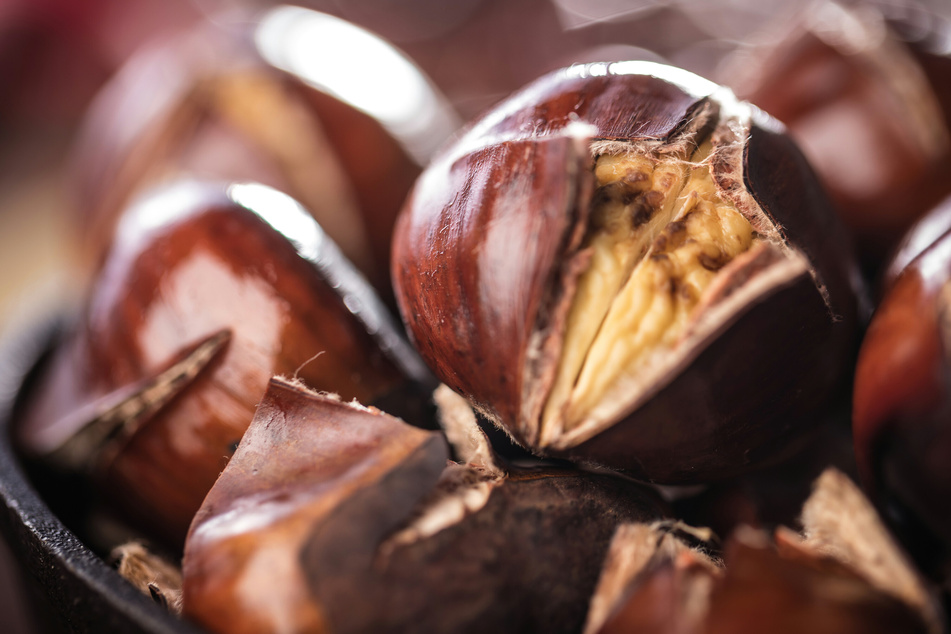When leaves fall from the trees, dogs love to frolic in the foliage and play with chestnuts. However, iHugDogs explains why dogs should never eat chestnuts.
Can dogs eat chestnuts? No!
When dogs play with chestnuts, they often chew on the nuts or even eat them. However, this can be very dangerous for the dog.
Chestnuts contain toxic saponins and glycosides for dogs.
To be poisoned, it is enough for the dog to absorb the toxins when biting into the chestnut through the mucous membranes in the mouth.
While the poisonous substances are truly life-threatening only when the dog ingests them in larger quantities, even small amounts can lead to diarrhea and vomiting.
If the dog has eaten chestnut pieces or whole chestnuts, this should never be underestimated.
Dog Ate Chestnut
If the dog has eaten chestnuts, it should be closely observed after the walk to detect possible symptoms and health problems early.
Chestnut Poisoning – Symptoms in Dogs
When a dog ingests the toxins from the chestnut, the symptoms depend on the amount consumed and the individual dog.
Possible symptoms with small amounts:
- Diarrhea
- Vomiting
Possible symptoms with larger amounts:
- Vision disturbances
- Paralysis
- Unconsciousness
Important
If there is suspicion that the dog is not doing well, or if you are unsure how much chestnut the animal has eaten, it should be examined by a veterinarian in any case.

Chestnuts as a Cause of Digestive Problems in Dogs
When dogs chew on chestnuts and swallow the pieces, the sharp edges can cause injury to the intestinal wall. An indication of this may be that the dog passes dark blood.
If the dog swallows a whole chestnut, this can, in the worst case, lead to intestinal obstruction.
Possible symptoms of intestinal obstruction:
- Fatigue
- Loss of appetite
- Little or no defecation
- Straining to defecate
- Vomiting of any food, liquid, and also feces
- Lethargy
- Bloated, tense, painful abdomen
If there is a suspicion that the dog has intestinal problems, a veterinary examination is urgently necessary. Intestinal obstruction must be surgically corrected and is always an emergency.
Tip
When out with the dog, always have a few toys as an alternative to chestnuts.
Are Chestnuts Poisonous to Dogs?
Just like horse chestnuts, both sweet chestnuts and edible chestnuts as varieties of the chestnut tree are poisonous to dogs when consumed in their raw state.
In addition, these are often covered by a prickly husk, which could also injure the dog’s mouth.

Can Dogs Eat Cooked Chestnuts?
When chestnuts and edible chestnuts are properly prepared, they are also suitable for dogs.
Cooked and peeled chestnuts make for a special snack, for example, as a reward. The nuts are particularly low in fat and contain many B-vitamins.
However, it is still possible that the dog may not tolerate the cooked chestnuts. For this reason, feeding should never be excessive.
A peeled and cooked chestnut can be a tasty snack for the dog from time to time, but it should never be fed in large quantities or as a complete meal.

Conclusion: Chestnuts are Poisonous to Dogs
When out with the dog in autumn, it is essential to ensure that it neither chews nor swallows chestnuts.
A peeled and cooked chestnut can be an occasional tasty snack for the dog.
If there is suspicion of health problems in the dog, it should be examined by a veterinarian.
Even if some dogs may enjoy playing with chestnuts in autumn, it’s better not to give them as toys.


